Ryan Hall's Blog, page 184
February 22, 2017
4 New Races To Get On Your Radar This Year
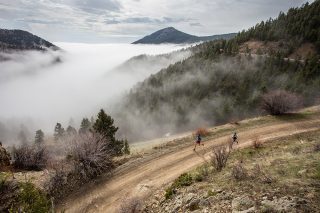
Boulder Mountain Marathon, Photo: Glen Delman Photography
It used to be that most races were predictable, serious affairs. The gun went off, you honed in on your target pace, battled an endless stretch of boring asphalt toward the distant finish line, and when you crossed it, gasping for air, you were herded like a reeling bovine through a paddock area to receive your allotment of banana bites, processed bagels, watered-down Gatorade, and if lucky, maybe a container of Yoplait yogurt.
Today, new running events are emerging that bring runners together in exciting places to push physical limits and immerse in destination-specific cultural interests. If you are willing to shell out some cash for registration and travel, you can find a race that takes you on a journey through a beautiful town or scenic trail system before dropping you off at a post-race party with good food, live music, or craft brews that will send you to the clouds before your heart rate heads south of 180.
We’re always looking to make running more fun, so here are four new races that came across our radar.
RELATED: 25 Short, Fast and Fun American Road Races of 2017
For hop-heads
IPA 10K + Beer Mile
Sebastopol, Calif.
April 15, 2017
For a themed race to succeed, authenticity is paramount. With a whopping 52 breweries, distilleries and cideries based in California’s Sonoma Country, it seems this event has the ingredients ready. Combine that with average April temperatures in the 70s in the quaint town of Sebastopol that Jerry Garcia once called home, and you have the potential for a five-star running weekend. Start the day at 7:55 a.m. with a runner’s beer toast before the gun goes off. After the race, head to a festival featuring music paired with libations from local craft breweries like Bear Republic, Lagunitas, Henhouse, and Petaluma Hills. Oh yeah…there’s also a beer mile.
For your first off-road marathon
Boulder Mountain Marathon and 10-Mile Ascent
Boulder, Colo.
May 21, 2017
Many consider Boulder the running capital of the world, and this event, which takes place primarily on dirt roads and double-track high above the iconic city at an elevation of 8,000 feet, only adds to its cred. This is the race for you if you want to hit the dirt and push yourself on high-altitude terrain that has toughened many a world-class runner— you’ll be rewarded with sweeping views of the Flatirons to the south, and the snow-capped peaks of Rocky Mountain National Park to the north. After the race finishes, enjoy a Salomon-sponsored party and refuel with an amazing local, organic meal by RAD (Real Athlete Diets) and craft suds by Avery. The event also features a point-to-point 10-Mile Ascent, which climbs a grueling 2,500 feet up to the finish.
For fit foodies
Buford Highway Half Marathon
Atlanta, Ga.
Oct. 1, 2017
The Buford Highway corridor just north of Atlanta is home to more than 1,000 immigrant-owned businesses, so it’s no surprise that this zone is an emergent foodie’s paradise. Burn calories over a half marathon, 10K, or 5K distance, and then dive into a festival that features cuisine from nine different restaurants—from Guatemalan and Columbian to Northern Chinese and Indonesian. Rumor has it the coconut buns from Hong Kong Bakery are the best post-race reward ever. Bon Appetit!
For your first 50
Dead Horse Ultra
Moab, Utah
Nov. 17, 2017
Thinking about a 50-mile trail race? To say this full-day desert journey didn’t disappoint is an understatement. The stunning sunrise, sci-fi-looking landscape of odd rock formations, sandstone canyon views, and largely runnable terrain in mild November temps, capped by a delicious post-race enchilada dinner, made this race a winner. Dead Horse began as a 50K two years ago, and on the heels of a successful effort, the producer, Mad Moose Events, rolled out the 50-mile in 2016. For 2017, they’ll offer 50-mile, 50K and 30K distances.
RELATED: 19 Challenging Yet Stunning Trail Races to Run in 2017
The post 4 New Races To Get On Your Radar This Year appeared first on Competitor.com.
February 21, 2017
Allow Us to Introduce You to Running’s First Lady Of Frosting

Jessica Hamel, founder and CEO of Frost’d, Photo: Josh Vertucci
Every Thursday night, Jessica Hamel is in an industrial kitchen mixing ingredients, lugging around giant bags of sugar and containers of coconut oil. Three years ago, the 31-year-old ultra-distance trail runner from Boulder, Colo., decided to put her passion for cooking and baking into a business and created Frost’d, a natural coconut oil-based “snacking frosting.”
“Ultrarunning increased my sweet tooth, and I didn’t want to eat all the junk that was out there,” Hamel says.
Hamel claims she loves Nutella, but that it’s full of artificial ingredients and contains dairy, which she avoids. She started tinkering in her kitchen and came up with the formula for Frost’d.
The “snack frostings” (spread it on pancakes, dip fruit in it … or just eat it with a spoon) have a coconut-oil base, and are vegan, dairy-free, gluten-free and GMO-free. Hamel jokes about how many ultrarunners have their own special diets and that her frosting is ultraunner-friendly. In fact, she’s amassed a following in the sport.
Frost’d sponsors runners Clare Gallagher, Hillary Allen, Cat Bradley and professional obstacle course racer Nicole Meracle with free product: 10-ounce jars of flavors Madagascar Bourbon Vanilla, Mexican Hot Chocolate and Honey Lavender Lemon.
Hamel began running during college at Northeastern University in Boston, and during a study abroad in South Africa.
At the time, she was sure she’d pursue a career in the fashion industry and move to New York City. She spectated the Boston Marathon and thought, “I could do this.”
She trained for the New York City Marathon, ran it in “around 4 hours,” and knew she wanted more. Then a move to Boulder and the adoption of her dog, Jack, inspired her to ditch the roads for the trails.
“Jack’s the primary reason I became a trail runner,” she says. “He’s my best running partner.”
The Kelty paced her during an attempted Fastest Known Time (FKT) on Southern Colorado’s 101-mile Rainbow Trail, running 26 miles. And Hamel says he’s run up to 30.
And though she’s tackled challenging events like Run Rabbit Run 100-miler, Never Summer 100K (where she placed third in 2015), the San Juan Solstice 50-miler and the Dead Horse 50-mile race, she’s not addicted to racing.
“I’m realizing I can go run 50 miles by myself and have an awesome time,” she says. Still, Hamel has her sights set on a future Hardrock 100, if she gets in.
“I really like to pace random strangers,” she says with a laugh, explaining how she’s been paired up with two different strangers at Hardrock, and has paced at Leadville, too. It’s more than just Frost’d that keeps Hamel busy though. She also juggles her own social media consulting company, and creates content for the Follow Your Passion Project—a collection of stories from fellow female entrepreneurs. Meanwhile, she’s coming out with two new frosting flavors: Coconut Tumeric and Rose Cardamom, and working toward single-packet servings. It all means Hamel sometimes runs less than she wants to. Still, she makes it happen.
“I know that it’s a necessary part of my routine,” she says. “It’s the only thing that really calms my brain down. I get my best ideas running.”
RELATED: 6 Guilt-Free Chocolate Bars for Runners to Indulge
The post Allow Us to Introduce You to Running’s First Lady Of Frosting appeared first on Competitor.com.
Shalane Flanagan Withdraws from 2017 Boston Marathon
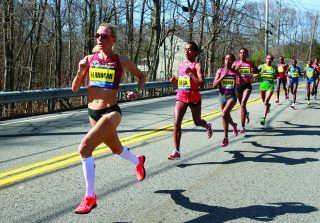
 Shalane Flanagan in the lead at the 2014 Boston Marathon. Photo: Photorun.net
Shalane Flanagan in the lead at the 2014 Boston Marathon. Photo: Photorun.net
Shalane Flanagan announced on Facebook that she will be withdrawing from this year’s Boston Marathon. According to her post, she fractured her lower back bone during a snowy training run in Portland, Ore. It was a tough call to make for the three-time Boston marathoner who has described Boston as her “favorite hometown race,” and has made it widely known that it’s her goal to win it one day.
This injury follows an impressive display of performances in 2016, including her 3rd place win at the U.S. Olympic Trials Marathon in February, a new American 10K record in June, and then her sixth place finish at the Summer Olympics in Rio. Although Flanagan has expressed her disappointment in her inability to compete on April 17, the tenacious marathoner is far from giving up and already hopeful of her return next year. “One thing I know, is that marathoners are used to suffering and overcoming challenges. We come back to try again…and again.”
RELATED: U.S. Olympic Marathoners are Boston Bound in 2017
The post Shalane Flanagan Withdraws from 2017 Boston Marathon appeared first on Competitor.com.
February 17, 2017
First Fastest Known Time of the Year Awards Announced
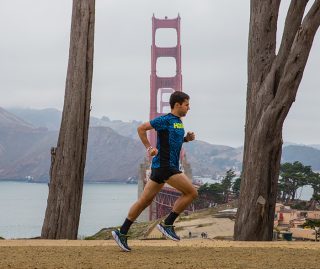
Ultrarunner Pete Kostelnick, shown here during a training run, set out from San Francisco with the intent of running across the U.S. in record time. Photo: Justin Britton/Hoka One One
Discussions of Fastest Known Time (FKT) records, which entail burly, independent efforts by diehard runners and adventurers, are often relegated to message boards and beers around a campfire instead of mainstream sports news and the glossy pages of magazines. But with more and more people establishing times on iconic routes, the concept, created by runners Peter Bakwin and Buzz Burrell, is becoming mainstream. And now, these adventurous runners have a chance to win the newly announced annual Fastest Known Time of the Year (FKTOY) award.
Heather “Anish” Anderson and Pete Kostelnick have been announced as the women’s and men’s FKTOY winners for 2016.
Anderson, who has completed 35 ultras and holds the overall self-supported (backpacker) records for the Appalachian and Pacific Crest Trails, set a new self-supported record for the Arizona Trail. The 35-year old from Washington State covered the 800-mile route in 19 days, 17 hours and 9 minutes, often in triple digit temperatures, two days faster than the men’s self-supported FKT.
“I never expected to be selected from such an amazing group of efforts on an incredibly wide variety of challenging routes,” says Anderson who is a personal trainer and Ultimate Direction Ambassador. “The Arizona Trail is an incredible wilderness trail and I am thankful to have experienced it in such a unique and challenging way.”
Kostelnick, who lives in Missouri and has completed 27 ultras and is a two-time winner of the Badwater Ultramarathon, won the honor by breaking the 36-year-old Trans America record by four days. Averaging over 72 miles a day for 6 weeks, the 29-year-old Hoka One One-sponsored athlete covered the 3,067 miles from San Francisco to New York City in 42 days, 6 hours and 30 minutes.
To be considered for the FKTOY, FKT holders must have their principal residence in the U.S. or Canada, the FKT may be anyplace in the world, in which documentation is required and the effort must have taken longer than one hour to accomplish.
Bakwin and Burrell created the Fastest Known Time website to track records and establish a protocol for documenting records. Documentation is essential to the process, with satellite trackers and third party verification required for a record effort to be recognized. Burrell also suggests anyone who wants to establish a speed record should announce his or her intentions in advance, invite others to join in the pursuit and document everything immediately.
According to Bakwin and Burrell, who also established the FKTOY awards, the annual competition “celebrates core qualities such as personal vision, creativity and determination.” A jury of 21 people, runners and adventurers in their own right, voted for the winners from a list of five nominated FKT records for men and women. With no fixed voting guidelines, voters judged records based on their own unique equation. Suggested parameters included: how much did the record “raise the bar”; were you inspired; how much research, planning and organization was required; did it establish a better style or new way of looking at a route; and how long the previous record stood, among others.
“The appeal of FKTs are their individualistic nature, requiring personal vision, creativity, and self-determination. These are the qualities that are core to ultrarunning in general and should be the ones future participants should look to achieve in their attempts,” says Burrell about what future FKTOY contenders should keep in mind. “A big part of being nominated is being able to inspire.”
RELATED: Inside the Fastest Known Time Trend
The post First Fastest Known Time of the Year Awards Announced appeared first on Competitor.com.
The Technology of Running
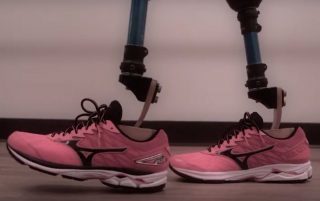
After losing both his legs to a rare form of meningococcal disease, Dell Miller vowed to return to running. Before, going for a run required little more than a pair of Mizuno Wave Riders. Now, it would require something far more advanced.
To view Dell’s full story, click here
“Dell, from day one, had goals for running,” says Matthew Mills of Hangar Prosthetics. “I was excited to work with him, to get him back doing what he loves to do. That is our job—as prosthetists, they come into our clinic and they are looking for restoration, to return and restore patients to activities they previously did, and in some cases more.”
Dell wanted more. His victory-lap ambitions included marathons around the world—his way of showing he had not only overcome adversity, but also transformed into a new and improved version of himself.
But first, he needed a new and improved version of his legs. Standard prosthetics, which have a full-length foot and heel, are too heavy and clumsy for running. As a team, Matt and Dell developed a customized pair of running blades made of lightweight carbon fiber. Just like selecting a perfect pair of running shoes, Dell considered everything from footstrike to flexibility. Many of the same technological ideals of his favorite Mizuno Wave Riders, like cushioning and energy transfer, applied to running blades.
Dell immersed himself in the design process. Every detail was selected with care and consideration. He could even customize his own stature.
“In Dell’s case, since both legs were amputated, he had a unique ability. While I was talking to Dell and having him walk, I asked him, “How tall do you want to be?” He had a huge smile, and gave his height requirement. I told him that over time, as he familiarized himself with a prosthesis and learning to walk again, I would continue to increase his height, as tall as he wanted to be. Naturally, Dell was thrilled with this offer. After several months and follow-up appointments, he stands right around 5 feet, ten inches.”
With every tweak and every follow-up visit, the product evolved beyond just carbon fiber—they became Dell’s legs, the limbs that would make him a runner once again.
“As a new prosthetic user, you don’t simply just put a prosthesis on and walk out the door and are never seen again,” Miller says. “It’s a process, and requires an excellent relationship between the prosthetist and patient. We monitor and make adjustments to ensure a perfect fit.”
As a runner, Dell knows all about a perfect fit. He found it before in the Mizuno Wave Rider, a wearable piece of technology that allowed him to go faster, farther, and more comfortably. Today, his technology has evolved to a new form—but the love of running remains the same.
The post The Technology of Running appeared first on Competitor.com.
February 16, 2017
Don’t Even Think About Crowdfunding Your Race Costs

Illustration: Valerie Brugos
When I was about 11 years old, I wanted—no, needed—a new bike. My heart insisted on a pink 10-speed in the window at the Hostel Shoppe in Stevens Point, Wis. But heart is not currency, and, as a kid, currency was scarce.
So I begged. I begged my parents for more chores, and when that wasn’t enough, I begged my neighbors to let me cut their grass, babysit their brats and wash their cars. I begged the people outside the grocery store until they bought my mediocre homemade cookies at French-pastry prices. I worked and saved until the day I gleefully took a hammer to my piggy bank at the cash register of the Hostel Shoppe.
Today, adult-me hires the neighbor kids to pull weeds and happily plunks down $3 for a slightly-burned snickerdoodle, because kid-me hasn’t forgotten what it’s like when passion and piggy bank fail to align.
But I will not contribute to your marathon GoFundMe.
The GoFundMe website is intended to aid in raising money for noble causes. Want to build a school for kids? Start a GoFundMe. Want to help a sick family member? GoFundMe, ASAP! Want to give a thousand orphaned kittens a home? Start a GoFundMe, and please include photos so I can make schmoompy noises. But if you simply want to race The Boston Marathon, GoFundYourself. (Unless you’re running for an important cause or nonprofit organization and fundraising money for it as well.)
About once a month, I get a request from strangers to promote a crowdfunding attempt for race costs. Sometimes it’s a person’s first marathon, sometimes it’s a bucket-list Ironman; more often than not, it’s just another race.
“Race fees are expensive!” They say. “Travel costs are through the roof! HELP ME ACHIEVE MY DREAM! SPREAD THE WORD!”
Right. Because there is no cause that deserves strangers’ philanthropy more than a hobby. I don’t know how anyone can browse this site, see a request to help a family replace a home that burned down in a Christmas Day fire, and think it appropriate to request $2,000 because you want—no, need—to fly cross-country for a marathon.
When did entitlement replace self-reliance? Have we forgotten there are bigger problems in the world than the exorbitant cost of destination races? I get it: It’s expensive. But that’s not a hardship. That’s your choice. That’s life.
If you want to fly to South Africa to race Comrades, start saving. If race fees cost too much, volunteer at the expo in exchange for free entry. If you want your dreams to come true, do the work to make it happen yourself. No one owes you a damn thing.
You best break out that piggy bank, kid.
RELATED: Out There—Just Read the Damn Article
The post Don’t Even Think About Crowdfunding Your Race Costs appeared first on Competitor.com.
6 Ways Acupuncture Can Benefit Runners
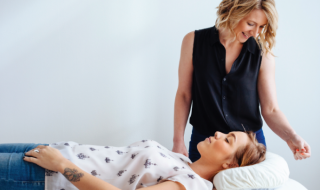
Sarah Hammer, L.Ac., a marathoner and licensed acupuncturist. Photo: Vev Studios
Acupuncture is a traditional Chinese medicine practice that involves inserting fine needles into the skin at certain points called acupoints, which, when stimulated, are thought to promote the body’s natural healing processes. Used by more than 3 million Americans each year, this ancient healing art has specific benefits for runners.
Sarah Hammer, L.Ac., a marathoner and acupuncturist in Portland, Ore., says that while most of her runner-patients initially seek treatment for pain or an injury, they often notice, as she did, that acupuncture also improves their overall health—which translates to stronger running. That’s because regardless of the specific ailment, acupuncture seeks to balance and restore energy throughout the body, she explains.
Here are six ways this centuries-old therapy can help you perform your best.
RELATED: Alternative Treatments for Running Injuries
Strengthens Your Immune System
Research shows that during periods of heavy training, your risk of acquiring an upper respiratory tract infection increases. According to the National Cancer Institute, acupuncture may help your body fight off infections by enhancing white blood cell activity. Several acupoints are associated with regulating immunity, but the key is to get treatments before you get sick, such as every two weeks during marathon training, Hammer says.
Corrects Muscle Imbalances
When muscles are imbalanced, they can trigger a chain reaction resulting in muscle, joint and tendon pain, says Matt Callison, L.Ac., a San Diego-based acupuncturist who trademarked Sports Medicine Acupuncture. To correct these imbalances, he inserts needles into motor points as well as specific acupuncture points to release tight segments of myofascial tissues—the membranes that surround and connect your muscles. “When you balance the muscles, you decrease the stress on irritated areas,” Callison says.
Accelerates Healing And Recovery
Clinical studies have amply documented that acupuncture improves blood circulation. “Because of the healing and growth factors in the blood, anything you can do to increase the amount of blood flow to an injured area, the better off it is,” Callison says. Acupuncture is especially helpful for healing tendons and ligaments, he says, which have been shown to have 7 percent less blood flow than muscles.
Protects Against Chronic Stress
Chronic stress undermines performance and wreaks havoc on our health. Recently, a team of Georgetown University researchers showed that acupuncture provides some resilience against chronic stress. In a series of animal studies, they found that acupuncture not only suppressed stress-related hormonal changes, but that the treatment’s effects lasted for four days. “Four days is quite long if you think of the effects of drugs, for example,” Dr. Ladan Eshkevari, who led the study, says. “Most drugs only last hours, not days.”
Improves Sleep
Recent clinical studies show that acupuncture promotes quality sleep, which runners know is critical to running strong, recovering well and preventing illness. Unfortunately, the CDC reports that nearly 10 percent of Americans suffer from chronic insomnia. “The reasons for poor sleep are different for every person, which is why acupuncture is so effective in treating it,” Hammer explains. “Unlike taking a pill, it gets to the root causes.”
It’s Mobile
Acupuncture pop-up clinics are part of a growing trend that brings the service to you. “Acupuncture can essentially be done anywhere,” says Hammer, who has treated runners during Hood to Coast, one of the world’s largest and longest relay races. “I wouldn’t be surprised if we don’t see more pop-up acu-clinics, like we see chair massages, at the end of races to enhance recovery.”
RELATED: 6 Proven Methods for Reducing Aches and Pains
The post 6 Ways Acupuncture Can Benefit Runners appeared first on Competitor.com.
5 Tech Trends You’ll See In 2017
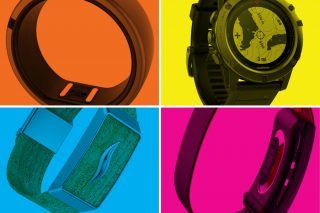
This year promises to be an exciting one for running tech: more wireless audio, the Apple Watch and Android Wear watches, longtime GPS watch brands upping their game, new and better physiology monitoring and apps are all in store. Even treadmills get interesting—with workouts following virtual, highly visual courses.
RELATED: Innovative New Music and Wearable Tech Gear for Running
Truly Wireless Music
With phones increasingly ditching the headphone jack, wireless and even totally wire-free audio will become the norm with improvements in battery life, sound quality, and in-ear heart rate sensing all becoming more common and less expensive. On the GPS watch front, Apple will emerge as an ever more significant player in audio through deep integration of its earphones to its OS. Jabra’s Elite Sport also senses heart rate and even repetitions, while Bragi and others all contend for our ears.
The Battle of the GPS Watch Platforms
Android Wear-based GPS watches from Polar, New Balance and others along with Apple Watch phone-free GPS apps such as Nike+ Run Club and Runkeeper will compete fiercely with the proprietary Garmin, Suunto and TomTom platforms for our run data. Will the downsides of Android Wear and Apple Watch—battery life, programming restrictions—hamper their popularity, or will the flexibility of adding apps for myriad day-to- day needs win out? The longtime players will not be standing still, with new form factors and options to encourage every-day, all-day use, along with training-specific apps. New on-watch capabilities will emerge, such as US TOPO and cycling maps preloaded and viewable on the new Garmin 5X with turn-by-turn alerts along routes, points of interest and map data overlays.
Run Form Sensing Gets Practical
Run form sensing and apps will get ever more sophisticated with an increasing focus not just on the data but what to do with it during and after the run. Clip-ons from companies such as Lumo and SHFT now coach on the run and provide pre-run tips, in-run feedback and post-run exercises. Others such as RunScribe capture and analyze foot, shoe and stride data, while Stryd gets at run power. The challenge for these will be in personalizing the coaching. The use of phone cameras emerged late in 2016 as a tool to analyze body mechanics and then recommend exercises with the Saucony Stride Lab app, which allows any runner to experience laboratory-style form assessment. As more of these types of apps emerge, getting accurate shoe recommendations from an app will become a reality.
Beyond Heart Rate Sensing
Wrist-based HR will become increasingly ubiquitous and reliable. Expect to see new styles to monitor heart rate, sleep and activity—even rings such as the new Motiv Ring. Resting heart rate, sleep patterns and other metrics of well-being and recovery are poised to become part of our training and daily routines. Expect simpler, more useful app displays of these data, along with breathing and meditation exercises to help runners balance training, stay healthy and manage stress. Fitbit, Apple, Whoop, The Wellbe, ZoomHRV and others have recently introduced such products and features. The challenge in 2017 will not be all that data—but how to easily understand and practically apply what it tells us day in, day out.
The Dreadmill Gets Less Boring
Platforms such as Zwift have recently become popular in the cycling world for making indoor trainer workouts less boring by following on-screen virtual courses while competing and riding with others worldwide, live. Early running betas and introductions from Zwift and Run Social have emerged. Because almost everybody finds the treadmill boring, we expect these virtual experiences to grow in capabilities and popularity
RELATED: 9 Tips and Tricks for Your GPS and Heart Rate Monitor
The post 5 Tech Trends You’ll See In 2017 appeared first on Competitor.com.
February 15, 2017
Cancer Survivor Completes DONNA Half Marathon in a Walking Boot
 Melissa O’Neil on Ponte Vedra Beach during the half marathon portion of her Booby Trap Challenge.
Melissa O’Neil on Ponte Vedra Beach during the half marathon portion of her Booby Trap Challenge.
The 10th running of the DONNA Marathon and Half Marathon to Finish Breast Cancer took place on Feb. 12. This year it raised more than $5 million and inspired more than 10,000 runners to participate in the various events, with individuals flocking from all 50 states and setting a new standard as the largest single DONNA Marathon weekend field. And, even more impressive, this year more breast cancer survivors than ever participated.
Donna Deegan, the founder of the DONNA Marathon, is a breast and lung cancer survivor, having served as the local newscaster for Jacksonville, Fla., for decades. More importantly, she is the catalyst for what is now a tremendous movement that raises funding for The DONNA Foundation, an organization that supports groundbreaking breast cancer research at the Mayo Clinic and also generously provides financial assistance to those living with breast cancer.
“There were so many milestones and so much love on the course. I am beyond grateful and, with this much joy surrounding us, I know we will just continue to build toward a world without breast cancer, ” said Deegan of this year’s event.
On the Friday preceding race weekend, a group of runners clad in pink (a prelude to the weekend’s color of choice) took part in the shakeout run on part of the marathon route along Neptune Beach. One of the runners, Melissa O’Neil, was wearing a walking boot, but nevertheless dressed to run.
Despite a broken bone in her foot, O’Neil was determined to complete the Booby Trap Challenge, which entails running a 10K and then a 5K on Saturday, and either the full or half marathon on Sunday. This was her seventh DONNA weekend and, as a two-time breast cancer survivor, the race is near and dear to her, her husband and her two children. She delayed foot surgery for the DONNA Marathon and told her surgeon that, as a survivor, she needed running as her outlet.
 Melissa approaches the half marathon finish line with her husband and son as proud escorts.
Melissa approaches the half marathon finish line with her husband and son as proud escorts.
O’Neil, 49, who is a nurse and lifelong athlete, was first diagnosed at the age of 30 when she was elbowed in the chest playing basketball—a blessing in disguise—and found a lump. After a mastectomy and reconstruction in 1997, she threw herself back into life. However, five years later, she found another lump in her armpit. The cancer had returned. She was given a 30 percent chance to live, and had surgery, chemo and radiation.
“During all of my treatments, I ran. It was God, me, and the road. At first, to me, running represented running away from cancer and my fears. I would run to clear my head. I would pray and sometimes cry,” O’Neil explained. Her first race was a 5K, the 2003 Seattle Race for the Cure, when she was still undergoing treatment. She said that when she was approaching the finish she heard her kids yell, “Go, Mommy, Go!” “Every emotion hit me and I realized I wasn’t running away from cancer, but I was running toward life.”
Having completed her 10K at 8 a.m. and the 5K at 10 a.m. on Saturday through downtown Jacksonville, O’Neil was set for Sunday’s half marathon, inspired by a fundraiser dinner at the Mayo Clinic, where doctors work hard in the labs to come up with a cure and, in some cases, have succeeded.
O’Neil finished the Booby Trap Challenge, as her husband, son and other family friends joined in the final miles of the run and became part of the parade to the finish.
Ahead of O’Neil, Joan Benoit-Samuelson, the first women’s Olympic Gold Marathon winner in 1984, claimed the top Booby Trap Challenge time(2:32:44) for the women’s half marathon. Meaghan Neuberger won the marathon (3:06:53), as did Matthew Barresi (2:30:23). A local high school student, Terrance Sessoms, who attends Marathon High, won the half in 1:18:22 while another local, Julie Stackhouse, took the half marathon win in 1:19:02.
RELATED: Cancer Survivor Carol Dellinger Completes 300th Marathon in Honolulu
The post Cancer Survivor Completes DONNA Half Marathon in a Walking Boot appeared first on Competitor.com.
February 14, 2017
Trails for All: Opening Up Trail Races to Visually Impaired Runners
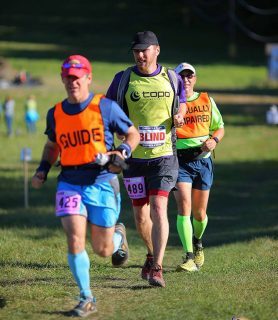
 Kyle Robidoux, sandwiched between guides Dane LeBlanc (front) and Ray Charbonneau at last year’s Vermont 50.
Kyle Robidoux, sandwiched between guides Dane LeBlanc (front) and Ray Charbonneau at last year’s Vermont 50.
There are some runners who make trail ultras look easy. Folks like Killian Jornett or Devon Yanko, for example. But even those at the top of their game will tell you running 50 or 100 miles is never an easy undertaking.
Imagine, then, adding an extra element of difficulty to the game. Say, running those same ultras without the benefit of sight. That’s just the challenge a growing number of ultra runners are proving doable. These visually impaired runners have decided their disability won’t get in their way of doing what they love. They’ve run 50Ks, 50-milers and even some of the most legendary monster runs, such as Leadville and Badwater, all within the same stringent cutoff times as their sighted counterparts.
Each will tell you, however, they couldn’t do it without their wingmen (or woman), skilled guides who offer up their vision to get visually impaired runners across the finish line. Together, the sighted and sight-challenged runners make up a determined, fierce team that can navigate the gnarliest of trails for miles on end.
RELATED: Guiding Amelia
Finding a way around
When 41-year old Kyle Robidoux was growing up he was an active kid and played an assortment of sports. As the genetic condition retinitis pigmentosa (RP) led to progressively limited vision in his 20s, however, he became less active and more convinced that he couldn’t run.
In his early 30s, overweight and a new father, Robidoux started walking in a nearby park to drop some pounds. “One day, in my work clothes and shoes, I just started running,” he says. “I tried again the next day for a little longer and then just started increasing my runs.”
It wasn’t long before Robidoux started running marathons, and after mastering the art of guided road running, the next step was getting onto trails. “I wanted to change up my training and I love being outdoors in nature,” Robidoux explains. “I started with shorter trail runs and progressed from there.”
Now he has an impressive number of ultras under his belt, all with the help of skilled guides by his side. “I have tunnel vision, so I like to run two steps behind my guides,” he says. “I can mostly follow his or her back but I can’t see anything of the terrain we’re covering.”
This is where a guide’s ability to call out all obstacles—from logs to roots to rocks and steps—becomes essential. Robidoux has a regular pool of guides from which to draw in New England, where he is based. “When you know your guide and run with him or her regularly, you can relax and trust that they will get you through it,” he says. “My favorite call out is ‘smooth sailing.’” That’s when the team hits a patch of smooth, buffed trail without anything technical to face.
In the course of a typical ultra, Robidoux will use several guides, usually in 15-mile increments. The job of guiding is not only physically taxing, but also mentally tiring, thanks to the laser focus it requires. He has found about half of his guides via United in Sight, a visually impaired and sighted runner matching service, which has been around since 2015.
One of Robidoux’s guides last year was Amy Rusiecki, a 37-year old ultra runner and race director of the Vermont 100. “Kyle first contacted me asking about qualifying for my race,” she says. “We got to talking and I offered to help guide him at a 60-mile qualifier.”
It was during their 15 miles together that Robidoux proposed an idea to Rusieck: Offering up a disabilities division at this year’s Vermont 100, the first of its kind at an ultra race.
“We talked about how to do this and what the advantages were on both of our ends,” she explains. “This is a group we want out there, and by having a division with a different set of regulations, it opens the race up to runners who otherwise might not be able to do it.”
Decorated ultra runner Maggie Guterl will be among Robidoux’s guides at the VT100 and looks forward to the job. “I’ve been guiding runners for three years with the Achilles team,” she says. “And when I heard he needed guides for Vermont, I volunteered.”
The day of the race may be Robidoux’s and Guterl’s first time running together, but that doesn’t concern either party. “What he’s doing is brave and cool, and having a chance to pace him will be fantastic,” Guterl says.
The master
 Jason Romero is guided through the dark by Brandon Stapanowich during the 2016 Spartathlon.
Jason Romero is guided through the dark by Brandon Stapanowich during the 2016 Spartathlon.
While he missed the cutoff for the Vermont 100 this year, Jason Romero, 46, from Denver, is perhaps trail running’s most well-known visually impaired runner. He can count Leadville 100, Badwater, Rim-to-Rim-to-Rim, and even a run across America in his list of accomplishments. He’s excited by the new division at Vermont this year: “Creating a challenged athlete’s division is a monumental step in acknowledging and inviting people with disabilities to challenge themselves at the highest levels,” he says. “We need more champions like Amy in all areas of life.”
Like Robidoux, Romero is impacted by RP, and hasn’t allowed it to take away from his enjoyment of trail running. “I have about 15 percent of my sight,” he explains. “It’s like looking through two toilet paper rolls.”
When logging his miles at night, Romero likes to use handheld flashlights and headlamps, along with reflectors on his guides’ ankles. He also likes running with experienced trail runners. “They’re going to take the path of least resistance and for a blind runner, that’s essential,” he says. “They also have to have a certain personality type.”
Romero wants a guide who isn’t going to be frightened of the task or pity him. “I almost want a drill sergeant,” he says. “My guide’s job is to get me from point A to point B before the cutoff. I want to compete.”
Since getting started on trails around 2010, Romero has seen the numbers of guided runners increase exponentially. “I’m amazed at how many more are hitting trails now,” he says, “but I want to see more. People with visual impairment can do so much more than they realize.”
Visit United in Stride if you are interesting in sharing your sight as a guide or if you are looking for a sighted guide near you.
RELATED: Visually Impaired Runner Chaz Davis Runs Record-Breaking Marathon
The post Trails for All: Opening Up Trail Races to Visually Impaired Runners appeared first on Competitor.com.
Ryan Hall's Blog
- Ryan Hall's profile
- 21 followers



